by Deep Green Resistance News Service | Dec 16, 2016 | Lobbying, Repression at Home
by Noah Weber
On Sunday, March 7, 1965, roughly 600 African Americans and their allies gathered and marched towards Montgomery, Alabama in order to take a stand and draw attention to the fact that 99% of Selma, Alabama’s registered voters were white, and that the African American community was being denied their legal right to vote. The unarmed men and women who marched across the Edmund Pettus Bridge were met by a heavily armed police force and were tear gassed and beaten horrifically. In the end, 17 marchers were hospitalized, and another 50 were treated for injuries caused by the police.
On Sunday, November 20, 2016, more than 400 Native Americans and their allies marched on the Backwater Bridge outside of Cannon Ball, North Dakota. The Water Protectors had been demonstrating peacefully for months in order to preserve sacred burial grounds and protect their only source of clean drinking water from the oil-bearing Dakota Access Pipeline. However, this unarmed march was meant to clear vehicles that had been set up by DAPL to block the Backwater Bridge. They were attempting to clear the road so that emergency medical vehicles could have faster access to the residents and campers at the Standing Rock Sioux Reservation. After being trapped on the bridge by heavily armed police, the marchers were hosed with water cannons in 23°F temperatures, and shot with rubber bullets, tear gas, pepper spray, and concussion grenades for more than 7 hours. 26 people were hospitalized, and more than 300 were treated for injuries caused by the police forces.
It is highly likely that neither group of marchers knew the full extent of the violence that they were about to experience as they marched on these bridges for the first time. However, they certainly knew what was in store for them for any subsequent actions. After the first march on Montgomery, the nation was horrified by the images broadcast by media sources, and on March 9, more than 2500 people showed up for the second march on Montgomery. Due to a pending decision, and a restraining order issued by Federal District Court Judge Frank Minis Johnson, the marchers turned around on the Pettus Bridge.
Ultimately, on March 17, Judge Johnson ruled that the civil rights activists’ right to march could not be abridged by the state of Alabama, writing “The law is clear that the right to petition one’s government for the redress of grievances may be exercised in large groups…by marching, even along public highways.” Meanwhile, on March 13th, President Lyndon Johnson met with Alabama Governor George Wallace in an attempt to prevent further violence and harassment from being directed at the civil rights activists. While unsuccessful with Wallace, President Johnson introduced a bill two days later to Congress. That bill became the Voting Rights Act. While it took time for the bill to pass, President Johnson deployed 2000 soldiers of the U.S. Army, 1900 Alabama National Guard troops under federal command, and unknown numbers of FBI and Federal Marshals to protect the demonstrators as they successfully continued their march on March 21.
When I showed up on November 24 to bring supplies and provide medical support at the Oceti Sakowin Camp, there were an estimated 3500 people at camp. When I left at the end of the week, there were roughly 10,000. Dozens of countries, and hundreds of tribes from around the world are expressing outrage and concern over the violence and harassment directed towards the Water Protectors at Standing Rock. These communities are also outraged that the pipeline was originally supposed to pass north of Bismarck, ND, but was rejected as being too dangerous to pass near that overwhelmingly white community’s water source, and instead was relocated to pass through traditional Lakota lands and under their Missouri River water source without any conversation regarding indigenous concerns and opposition to the pipeline.
Governor Jack Dalrymple of North Dakota is escalating his rhetoric towards the safety of the people camped at Standing Rock. He has threatened anyone bringing food and clothing donations to the camps with $1000 fines. This week, he threatened to oust the Water Protectors from their camps in the name of safety, due to winter conditions. However, the Water Protectors are not going to leave, and making someone homeless in winter is unconscionable. Using water cannons on peaceful demonstrators in sub-freezing temperatures shows that safety is not Dalrymple’s top priority. Getting people to vacate the land is his priority.
The Water Protectors are going to continue to march, pray, and peacefully demonstrate, regardless of the violent reactions from DAPL security and police forces. They are doing everything that they can to stand up for their rights in a peaceful manner. They are waiting for action from President Obama. It is time for a sit-down between President Obama and Gov. Dalrymple. It is also time for an immediate and decisive response from the Obama administration to ensure the safety of peacefully assembled citizens and their right to clean water. This means troops standing with the Water Protectors, not opposed to them. President Johnson was not perfect, but he has been judged by this nation, and the world, to have been on the correct side of history on civil rights in the wake of Bloody Sunday. Due to the shared history of abuse and denied rights, despite laws and treaties on their side, it is difficult to see why President Obama praises one group’s actions, but has yet to do anything of substance for the other.
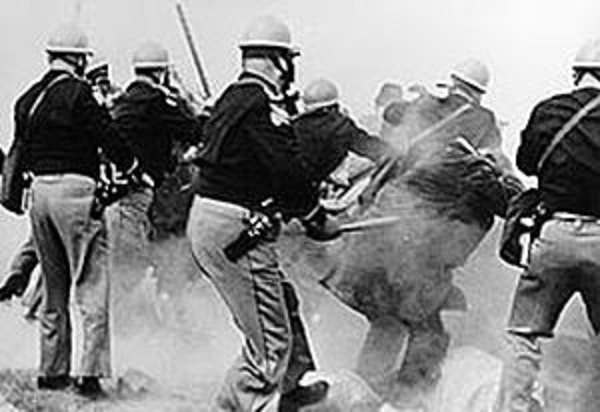
Bloody Sunday
When will troops protect the Water Protectors? So far the only troops acting in such a capacity are the veterans recruited by Wes Clark Jr. My thanks go out to Mr. Clark and his veterans. However, anything short of deploying troops to protect the peacefully assembled demonstrators, in conjunction with pushing a bill through Congress to extend the rights of indigenous communities over the governance of their own land, would be a shameful act by the Obama administration. This is your Pettus Bridge, Mr. President. On which side of this historic bridge do you stand?
Taking the least effective route to enact change is not praiseworthy. A teacher would award a D for such effort.
While the ruling by the Army Corps of Engineers sounds nice, demonstrators are still fighting for Lakota rights on land that is considered to be federally-owned, but was granted to the Lakota “in perpetuity” by the government. The Lakota never relinquished their right to this land. The government took it.
There are still Federal Police and Army Corps vehicles on Lakota land. They are still on the north side of Cantapeta Creek…with the DAPL security forces. I will believe something has changed when Federal forces are standing shoulder-to-shoulder WITH the Standing Rock Water Protectors, indigenous rights have been extended by law, and the pipeline is re-routed or terminated. Until this happens, nothing has changed.
Noah Weber is a nurse and a farmer from Montana. He volunteered as a medic at the Oceti Sakowin Camp at Standing Rock, though most of his time went to ensuring everyone in the medic, healer, midwifery, and warming tents had wood, warmth, and functional stoves.
Featured image: Standing Rock, by Rob Wilson
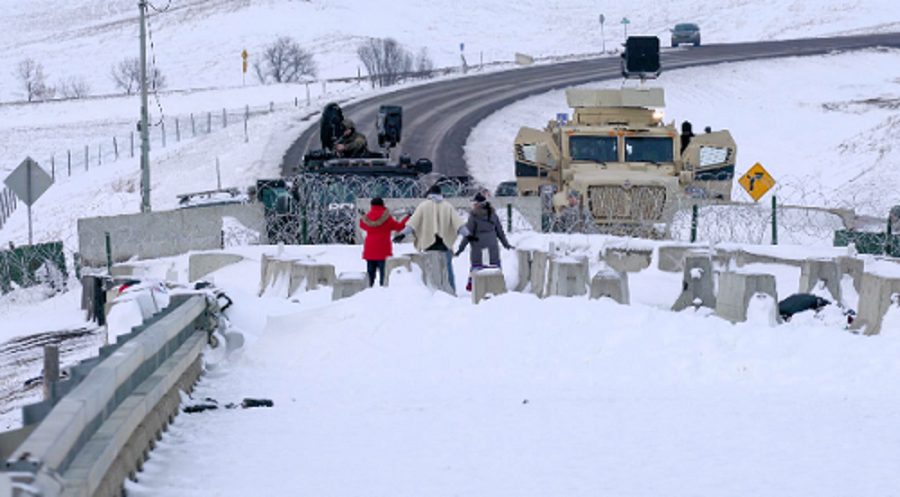
by Deep Green Resistance News Service | Dec 5, 2016 | Obstruction & Occupation
by Indigenous Environmental Network
Cannonball, ND – At approximately 3PM CST a group of about 30 people gathered to create a protective prayer line on the Backwater Bridge, the site of the November 20th attack on peaceful and unarmed water protectors by militarized police. Wesley Clark Jr., an organizer of Veterans Stand with Standing Rock, Kandi Mossett of the Indigenous Environmental Network, and Brenda White Bull who served 20 years in the Marine Corps and is also a direct descendant of Chief Sitting Bull, delivered a message to representatives of the National Guard, the Veterans Association, Tigerswan Private Security, who is hired by DAPL, and North Dakota law enforcement.
Wesley, Kandi, and Brenda walked together across the bridge to have a discussion with representatives on the other side. The purpose of the discussion was to clarify that the delegation of more than 2,000 veterans comes in peace and will remain nonviolent and in prayer during their visit to Standing Rock.
Further discussion was had about resolving tension between Water Protectors and law enforcement and also about the barricade on the bridge, which poses a danger not only to the camps but also the Cannon Ball community as it blocks the fastest route for emergency services. An audio recording of the meeting confirms that North Dakota law enforcement will not be entering the camp.
From December 4th through 7th, 2,000 veterans will descend on Standing Rock to act as a human shield for the water protectors on the front lines of the peaceful protest. The Veterans will also act as protectors of the Oceti Sakowin camp after the Army Corps of Engineers and North Dakota Governor, Jack Dalrymple, have called for its December 5th evacuation.
For Live updates at Standing Rock and the Veterans’ visit, please follow Indigenous Rising Media on Facebook.
Featured image by Spencer Mann, Indigenous Rising Media
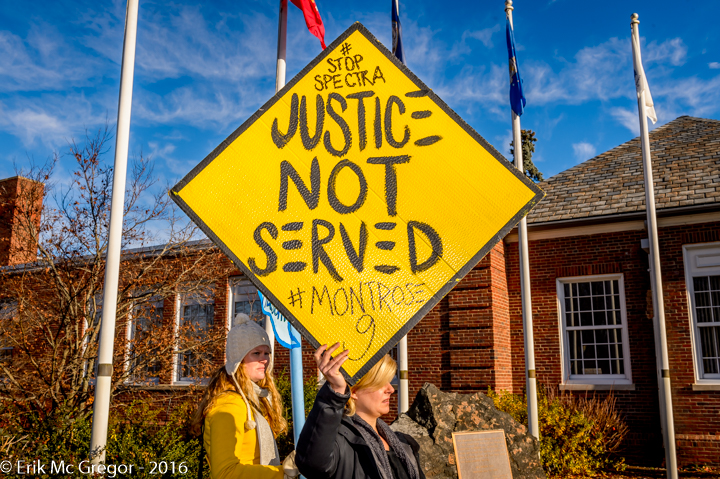
by Deep Green Resistance News Service | Dec 3, 2016 | Obstruction & Occupation
by ResistAIM
Cortlandt, NY — Four months after conclusion of the trial, today Judge Daniel McCarthy found the “Montrose 9” guilty of disorderly conduct for blocking traffic in Cortlandt Town Court. The “Montrose 9,” local residents and environmental advocates who were arrested for blocking access to a ware yard in Montrose to halt construction of Spectra Energy’s AIM pipeline on November 9, 2015, claimed that their actions were necessary to prevent a greater harm.
At the Press Conference after Judge McCarthy’s verdict, Defense Counsel, Martin Stolar, a prominent social justice attorney, said “I am extremely disappointed with respect to the necessity defense, which seems so obviously true. We will take it up on appeal. They (the defendants) are heroes, not criminals.”
After months of delay, testimony from the defendants ended on July 22, 2016. Many of the defendants expressed their concerns about global climate change and environmental damage from the fracked methane gas the pipeline will carry, fear of pipeline explosions and the possibility of another “Fukushima on the Hudson.”
Their goal at trial was to prove that the violation they committed – blockading Spectra from constructing a fracked gas pipeline – was necessary to prevent a greater harm. They demonstrated that Spectra Energy’s AIM pipeline presents immediate risks from explosions and impacts the health and safety of the community. Additionally, they noted that the fossil fuel industry is locking our nation into an unsustainable future of fossil fuels at a time when the country has to move towards renewable energy resources. They made clear that although members of the community had been diligently working through regulatory channels, their efforts were stymied by interminable delays and legal maneuvers, leaving them no recourse but to pursue non-violent direct action.
Although today’s ruling was not the outcome that many present had hoped for, the Montrose 9 and their allies said that they plan to continue the fight.
Marty Stolar: “Judge McCarthy’s verdict is guilty. The Judge rejects the justification as being speculative and the harm is not imminent or about to occur. He then rejects our First Amendment defense, and that the prosecution has proved its case beyond a reasonable doubt. The justification defense which he rejects, we all know, and you all know, the actions were justified, the harm is imminent, and the pipeline is extraordinarily dangerous, and constitutes a present harm and a present threat to every resident in this town, in this county and of the areas surrounding Indian Point. An appeal will be led after the sentence is imposed on January 6th.”
Susan Rutman: “It is absolutely staggering. This decision is disrespectful. But we will persevere. We cannot be thwarted by the limited scope of the legal system. He (the judge) wouldn’t even make a declaratory statement.”
Andrew Ryan: “This furthers my belief that we are run by a Corp-ocracy. They are people who care only about profits. They create and they interpret the law.”
For over three years, these concerned residents along with a number of groups in Westchester County, petitioned the Federal Energy Regulatory Commission (FERC) asking for an independent and transparent study to be done before allowing Spectra’s dangerous Algonquin Incremental Market (AIM) pipeline to be built. Their concerns, and those of elected officials at all levels of government, were ignored; FERC similarly dismissed the concerns of nuclear safety experts and pipeline experts. This refusal of FERC to acknowledge or address health and safety concerns meant that the local community had no legal or policy recourse, which supported their claim of necessity defense.
As of today’s date, Spectra still has not completed pipeline construction as the project has encountered environmental violations, noise complaints, and legal challenges. For months they have tried and failed to run the 42” pipeline under the Hudson River adjacent to Indian Point Nuclear Power Plant, with another attempt slated for this month. As a stop gap measure to bypass their failed river section and salvage the project, FERC granted permission to Spectra Energy to run additional gas through existing pipelines under the Hudson and Indian Point Nuclear Power Plant. This scenario, running additional gas through 50- and 60-year-old pipelines under the plant, was never examined by FERC or the Nuclear Regulatory Commission for safety and was not a condition granted in the FERC permit.
It is the latest in a string of examples of FERC’s failure to address safety concerns or act in the best interests of public heath and safety. In fact, today, members of ResistSpectra, Safe Energy Rights Group (SEnRG), and Stop the Algonquin Pipeline Expansion (SAPE) are in Washington DC attending The Peoples’ Hearing, where representatives of impacted communities will provide testimony and evidence of FERC’s abuses of power and law across the country. Their evidence will demonstrate to Congress the need to reform this rogue agency and reexamine their authority under the Natural Gas Act.
Find out more information about the AIM Pipeline and ongoing resistance here:
Online: www.resistaim.com
On Facebook: www.facebook.com/resistaim
On Twitter: https://twitter.com/ResistAIM
Photos by Erik McGregor
Video Andy Ryan: https://www.youtube.com/watch?v=UZLS_FIvK9Q
Video Kim Fraczek: https://www.youtube.com/watch?v=B0omT34SWw8&t=36s
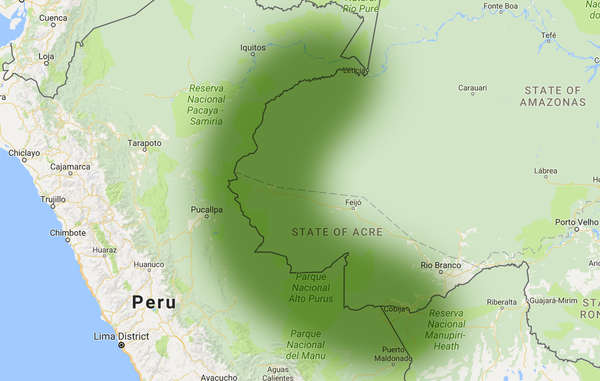
by Deep Green Resistance News Service | Dec 1, 2016 | Colonialism & Conquest
Featured image: The Amazon Uncontacted Frontier, a large area on the Peru-Brazil border that is home to the largest concentration of uncontacted tribes in the world. © Survival International
By Survival International
A new “death road” advocated by a notorious Italian priest is set to cut in two the land of several uncontacted tribes in the heartland of the Amazon Uncontacted Frontier.
The road is expected to be approved by Peru’s congress soon, and will run through 270 km of the Amazon’s most biodiverse and sensitive protected areas.
The project has been supported for years by Father Miguel Piovesan, a Catholic priest who has described the local tribal peoples as “prehistoric,” and slammed international NGOs for raising concerns about the plan.
The road was rejected by Peru’s Congress in 2012. Despite this, work continued illegally for many years, and now the project has been proposed again by Congressman Carlos Tubino.
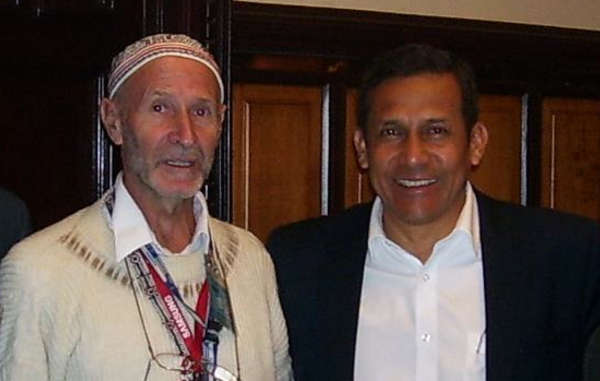
Fr. Miguel Piovesan, the main backer of the Purus road, alongside former President Ollanta Humala.
© Anon
Uncontacted tribes are the most vulnerable peoples on the planet. There are estimated to be around 15 uncontacted peoples in Peru, many of them in the region where the road will be built.
Survival International has lodged a complaint with the United Nations, citing the catastrophic impact on the uncontacted Indians and urging the Peruvian government to veto the plan.
Of the 3-4,000 people in the area, around 80% are indigenous. Most of them are opposed to the road.
Emilio Montes, president of the indigenous organization FECONAPU, which is based in Puerto Esperanza said: “We flatly reject this road. We indigenous people won’t benefit from it, only the loggers, miners, oil companies and narcotraffickers. It threatens the lives of our isolated relatives, like the Mashco Piro. It will destroy our animals and plants. They should, instead, respect our ancestral territories. We’ve always lived here, and our children must carry on doing so. We need another type of development which looks after our resources sustainably: so that we can live properly, and secure our future.”
Survival’s Director Stephen Corry said: “If this road goes ahead, it will destroy the uncontacted tribes, and their “development” will be terminated for ever. Survival has fought roads in this part of Amazonia for decades. Who are they supposed to help? If Peru has any respect for fundamental human rights and the rule of law, it must stop these plans now.”
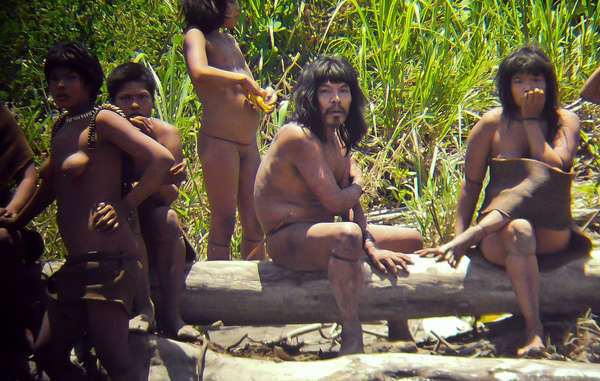
Uncontacted Mashco-Piro Indians on a riverbank near the Manú National Park. 2011.
© Jean-Paul Van Belle
Background
- The road will connect Puerto Esperanza to the Inter-Oceanic Highway, which runs through Peru and Brazil. The area is part of the Amazon Uncontacted Frontier, the region along the Peru-Brazil border with the highest concentration of uncontacted tribes in the world.
- Uncontacted peoples who could be wiped out if the road is built include the Mashco Piro, Chitonahua, Mastanahua and Sapanawa, who have all lived nomadically in the region for generations. Outsiders such as missionaries and loggers have forced several groups to make contact in recent years.
- Elsewhere in the Amazon, road “development” projects have allowed an influx of colonists to access remote areas and threaten the lives and lands of uncontacted peoples.
- Several indigenous organizations in Peru have made a statement rejecting the road.
- Fr. Piovesan has repeatedly denied the existence of uncontacted peoples. His parish newsletter stated that: “Isolation is not a natural wish. We can’t prove that isolated people exist. They are dreamt up by those who barely know indigenous people, or base their investigations on unproven theories.”
- Uncontacted Indians have clearly expressed their desire to remain uncontacted. The project cannot be carried out with their consent and will violate their right to determine their own futures.
We know very little about uncontacted tribes. But we do know there are more than a hundred around the world. And we know whole populations are being wiped out by genocidal violence from outsiders who steal their land and resources, and by diseases like flu and measles to which they have no resistance.
Uncontacted tribes are not backward and primitive relics of a remote past. They are our contemporaries and a vitally important part of humankind’s diversity. Where their rights are respected, they continue to thrive.
All uncontacted tribal peoples face catastrophe unless their land is protected. Survival International are doing everything we can to secure their land for them, and to give them the chance to determine their own futures.
by Deep Green Resistance News Service | Nov 27, 2016 | Obstruction & Occupation
Featured image: The Oceti Sakowin camp is currently home to thousands of water protectors and allies. (Photo: Reuters)
by Deirdre Fulton / Common Dreams
The U.S. Army Corps of Engineers on Friday informed Indigenous water protectors and their allies that they have nine days to vacate the main Dakota Access Pipeline protest camp—or else face arrest.
“This decision is necessary to protect the general public from the violent confrontation between protestors and law enforcement officials that have occurred in this area, and to prevent death, illness, or serious injury to inhabitants of encampments due to the harsh North Dakota winter conditions,” Col. John Henderson of the Corps said in a letter to the Standing Rock Sioux Tribe chairman Dave Archambault II.
The Oceti Sakowin camp, on the banks of the Cannonball River, will be closed Monday, December 5, the letter warned. Any individuals found on Army land north of the river after that date would be considered trespassing and could be prosecuted.
The Corps said it would establish a “free speech zone” south of the Cannonball River on Army lands.
But Dallas Goldtooth of the Indigenous Environmental Network (IEN), told the Bismarck Tribune that “there’s not enough land on the south side of the river where many are already camping; and a planned winter camp on 50 acres of reservation land near Cannon Ball is not yet ready, with groundbreaking set for next week.”
What’s more, he noted that “the eviction deadline is the day after more than 2,000 American war veterans are scheduled to arrive at the camp to stand in solidarity with Standing Rock,” the Tribune reports.
Archambault issued a statement in response to the Corps, saying the Standing Rock Sioux Tribe “is deeply disappointed in this decision by the United States, but our resolve to protect our water is stronger than ever.”
“It is both unfortunate and ironic that this announcement comes the day after this country celebrates Thanksgiving—a historic exchange of goodwill between Native Americans and the first immigrants from Europe,” he continued. “Although the news is saddening, it is not at all surprising given the last 500 years of the treatment of our people. We have suffered much, but we still have hope that the President will act on his commitment to close the chapter of broken promises to our people and especially our children.”
Indian Country Today reports:
The notice from the Army Corps comes less than a week after Morton County Sheriff’s deputies sprayed rubber bullets, mace and water on more than 400 people demonstrating at a bridge blockade not far from the camps. Temperatures were below freezing when protectors were repeatedly hosed down by police that Sunday night, November 20. There have also been reports that concussion grenades were fired at protectors. Dozens were hospitalized, including 21-year-old Sophia Wilansky, who may face the amputation of her arm, and Cheree Lynn Soloman, who is fundraising for eye surgery.
“If you were concerned about the safety of the fucking people you would have taken your ass out there and you would’ve cut their fucking hoses,” lamented Kash Jackson, an Army veteran from Michigan. His Facebook LIVE rant was broadcast shortly after the Corps announced its warning to water protectors that anyone choosing to stay on Corps land beyond December 5 would be doing so “at their own risk.”
“You stand firm, Standing Rock,” Jackson continued. “You stand firm right where you’re at. They want to push you off that land. It’s not their land to begin with.”
Meanwhile, IEN said in a statement: “We stand by our relatives of the Oceti Sakowin and reaffirm their territorial rights set in the Fort Laramie Treaty of 1851. If the Corps wants to keep people safe and prevent further harm, then deny the easement, rescind the permit, order a full Environmental Impact Statement, and send Department of Justice observers.”
“This decision by the Army Corps and the United States is short-sighted and dangerous,” the statement read. “We have already seen critical injuries cased by the actions of a militarized law enforcement. We implore President Obama and the White House to take corrective measures and to stop the Dakota Access Pipeline once and for all.”
The group, along with Honor the Earth, the International Youth Council, and the Camp of the Sacred Stones, is planning a news conference for Saturday afternoon, which IEN will live-stream from its Facebook page.
Filmmaker Josh Fox, who has been outspoken in his opposition to the crude oil pipeline, called the Corps’ eviction notice “a major act of aggression against basic rights of peaceful assembly and protest in the U.S. and constitutes a violation of treaties as well as the U.S. constitution’s guaranteed right to protest and assemble.”
“Oceti Sakowin, the main camp for water protectors, is a beautiful self-organizing community,” Fox continued. “It stands as not only the main place for the protest movement to assemble and organize, but it also represents a major leap forward for our combined movements for the environment, Indigenous sovereignty, and real democracy in America. If the Army Corps tears down this protest camp hundreds more will spring up in its place. A crucial alliance between indigenous values, native sovereignty and environmental movements has been forged here. We expect that the Standing Rock movement will find new and creative ways to fight the Dakota Access Pipeline no matter what, and that the Standing Rock movement and its alliances will find many areas of common ground and protest. We will fight fracking. We will fight pipelines.”
This article was originally published at Common Dreams, and re-published at Deep Green Resistance News Service under a Creative Commons license.






